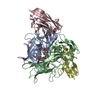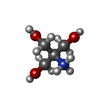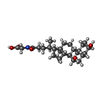+Search query
-Structure paper
| Title | Nanobody-Mediated Neutralization Reveals an Achilles Heel for Norovirus. |
|---|---|
| Journal, issue, pages | J Virol, Vol. 94, Issue 13, Year 2020 |
| Publish date | Jun 16, 2020 |
 Authors Authors | Anna D Koromyslova / Jessica M Devant / Turgay Kilic / Charles D Sabin / Virginie Malak / Grant S Hansman /  |
| PubMed Abstract | Human norovirus frequently causes outbreaks of acute gastroenteritis. Although discovered more than five decades ago, antiviral development has, until recently, been hampered by the lack of a ...Human norovirus frequently causes outbreaks of acute gastroenteritis. Although discovered more than five decades ago, antiviral development has, until recently, been hampered by the lack of a reliable human norovirus cell culture system. Nevertheless, a lot of pathogenesis studies were accomplished using murine norovirus (MNV), which can be grown routinely in cell culture. In this study, we analyzed a sizeable library of nanobodies that were raised against the murine norovirus virion with the main purpose of developing nanobody-based inhibitors. We discovered two types of neutralizing nanobodies and analyzed the inhibition mechanisms using X-ray crystallography, cryo-electron microscopy (cryo-EM), and cell culture techniques. The first type bound on the top region of the protruding (P) domain. Interestingly, this nanobody binding region closely overlapped the MNV receptor-binding site and collectively shared numerous P domain-binding residues. In addition, we showed that these nanobodies competed with the soluble receptor, and this action blocked virion attachment to cultured cells. The second type bound at a dimeric interface on the lower side of the P dimer. We discovered that these nanobodies disrupted a structural change in the capsid associated with binding cofactors (i.e., metal cations/bile acid). Indeed, we found that capsids underwent major conformational changes following addition of Mg or Ca Ultimately, these nanobodies directly obstructed a structural modification reserved for a postreceptor attachment stage. Altogether, our new data show that nanobody-based inhibition could occur by blocking functional and structural capsid properties. This research discovered and analyzed two different types of MNV-neutralizing nanobodies. The top-binding nanobodies sterically inhibited the receptor-binding site, whereas the dimeric-binding nanobodies interfered with a structural modification associated with cofactor binding. Moreover, we found that the capsid contained a number of vulnerable regions that were essential for viral replication. In fact, the capsid appeared to be organized in a state of flux, which could be important for cofactor/receptor-binding functions. Blocking these capsid-binding events with nanobodies directly inhibited essential capsid functions. Moreover, a number of MNV-specific nanobody binding epitopes were comparable to human norovirus-specific nanobody inhibitors. Therefore, this additional structural and inhibition information could be further exploited in the development of human norovirus antivirals. |
 External links External links |  J Virol / J Virol /  PubMed:32321816 / PubMed:32321816 /  PubMed Central PubMed Central |
| Methods | EM (single particle) / X-ray diffraction |
| Resolution | 1.72 - 4.7 Å |
| Structure data |  EMDB-10596:  EMDB-10597:  EMDB-10598:  EMDB-10599:  EMDB-10600:  PDB-6xw4:  PDB-6xw5:  PDB-6xw6:  PDB-6xw7: |
| Chemicals |  ChemComp-EDO:  ChemComp-HOH:  ChemComp-TRS:  ChemComp-MG:  ChemComp-CHO: |
| Source |
|
 Keywords Keywords |  VIRAL PROTEIN / MNV / neutralizing nanobody / VHH / VIRAL PROTEIN / MNV / neutralizing nanobody / VHH /  norovirus norovirus |
 Movie
Movie Controller
Controller Structure viewers
Structure viewers About Yorodumi Papers
About Yorodumi Papers






